Autumn Royal Apricot History
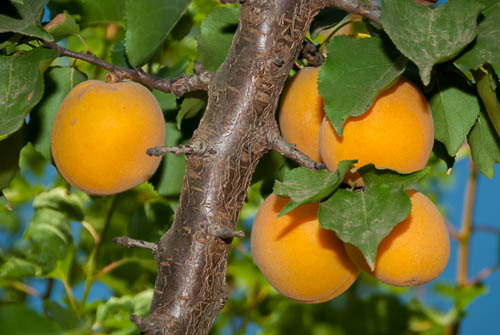
AUTUMN ROYAL APRICOT
L. E. Cooke Patent #2906
Andrew W. Kannonin, Hollister, California had a Blenheim Apricot orchard. In the orchard was a tree with one sport limb that flowered similar to the rest of the tree but the fruit did not ripen until September 15.
Nephew Don Moore (Moore's Western Nursery in Atascadero, CA) shared this information with Bob Ludekens who, along with business partner George Daniels, drove to Hollister to see the fruit quality. We budded a few trees and planted in our research orchard. In our San Joaquin Valley the fruit ripens in late August. The company filed for a patent December 18, 1967 and patent was granted July 15, 1969.
The Autumn Royal produces a Blenheim Apricot into mid September depending where it is planted. This is the latest known apricot making it very unique. The tree should be grown in climates such as the San Francisco Bay area to inland in Southern California.
Autumn Royal is not a good choice for the >100° F. Central Valley where it will pit burn and split open in the summer. In a normal summer we can have fruit from our larger trees that shade the fruit. When the tree is small the fruit can pit burn or when 115° the fruit splits open.
Autumn Royal does well in the Royal/Blenheim areas where the summer heat is normally less than 100°, such as Montebello, Whittier, San Gabriel, Vista, inland coastal areas with enough chilling for Blenheim. The fruit is the fine quality of Blenheim/Royal Apricot.
Most all apricots are ripening in June/July with a few new selections now in May. Autumn Royal is the only selection we know of after July and mid September makes it very unique.
Robert Ludekens 12-26-2013
Autumn Royal Apricot Information Pags - Point of Sale Page
Golden Amber Apricot History

GOLDEN AMBER APRICOT
L. E. Cooke Patent #3067 (Filed September 18, 1969)
Willard Clayton Hill had a Tilton Apricot orchard on Caldwell Ave, Visalia, California. He told Bob Ludekens about one tree in his orchard that flowered over a 30 day period and produced apricots ripening for 30 days. The extended time was not good for commercial plantings but is what a homeowner would want. When a tree has fruit ripening all in a few days, most is lost by the homeowner as they prefer to pick their fruit over a longer period, similar to berries.
Golden Amber produces the large fruit similar to a Tilton and is great for hot areas as it is the only late (July) fruiting apricot that does not pit burn in the May/June/July 100° weather of our san Joaquin Valley. The fruit is strong flavored and freestone that makes great halves with no soft flesh in the pit area from heat.
The 30 day bloom period is an advantage in the areas with late spring freezes. The spring freeze may get some flowers but others still fruit.
The tree is not a showy flowering trees since the bloom is spread over 30 days but has a high quality fruit in areas with late spring freeze and 100° May/June heat that pit burns most apricots. Golden Amber produces very large solid fruit with great flavor. The variety is a top choice like Tilton for dried apricots as they make good halves with strong flavor. Also it is excellent as frozen fruit and great on waffles in the winter. Tilton and Golden Amber are the only apricots Mrs. Robert Ludekens chooses to pick with 18 varieties close to their home.
1. Prolonged progressive blooming.
2. Prolonged progressive fruiting.
3. Pit burn resistant.
4. Large size fruit.
5. Excellent flavor.
6. Self fertile.
7. Good halves for drying, freezing, etc.
Robert Ludekens 12-26-2013
Royalty Apricot History

ROYALTY APRICOT
This very large early fruiting apricot was introduced to the L. E. Cooke Co in 1970 by Walter Krause of Redwood Nursery, Reedley, California.
Royalty sets fruit as a young tree and ripens for us in early June. The tree sets very large fruit on the heavy wood in the tree which is an asset in windy areas.
The variety is freestone, self fertile, very large, good flavor, ripening very early before the summer heat. The original trees were sold by Mr. Krause in Idaho, Utah, Michigan and the California San Joaquin Valley. While the fruit quality is large and excellent flavor, the tree does not set a heavy crop. Fruit size mitigates some of this.
Robert Ludekens 12-26-2013
Moniqui Apricot History

MONIQUI APRICOT
Mr. Andy Mariani , Mariani Orchards in Morgan Hill, California, supplied budwood for this variety during the summer of 1990.
Moniqui is from Spain. It grows in areas with chill from 600 to 1000 hours. A very unique fruit with sweet white juicy flesh with a coral pink blush to the skin with golden highlights on both ends.
The tree is a very vigorous grower, large leaves, resistant to bacterial canker. The fruit is large with tender white flesh and thick firm skin which makes it suitable for fresh market. Flesh has a sweet, melon like flavor and melting texture.
The variety does not seem to be as susceptible to normal apricot disorders with very little evidence of brown rot, sunburn, or pit burn.
Large size, white flesh, sweet dessert quality makes the fruit a good home variety.
Robert Ludekens 12-26-2013
Autumn Rosa Plum History

AUTUMN ROSA PLUM
The Autumn Rosa Plum is medium to large heart shaped fruit. The skin has a bloom similar to some grape varieties. When the bloom is removed, the skin is very shiny maroon to red with an amber cast. If the fruit is in full sun it is very maroon, if in the shade has more red with the amber shading.
The flesh is amber color, moist but very firm, and a heavy fruit for its size. The pit is small resulting in an abundant amount of excellent flavored flesh. The fruit ripens over a long period and holds well on the tree. The fruit is ripe from early to late September. 400 to 500 hours of chill is necessary. The tree is self fertile and is a pollinizer for Mariposa and Satsuma plums.
Autumn Rosa is the latest ripening of our current plums which means many hours of sun building sugar and flavor. I personally prefer this variety to Santa Rosa for flavor and specially the moist smooth golden flesh with the small pit and not dripping juicy.
It is unfortunate there is not more interest in the variety with the late ripening. If it was an earlier variety it would be well known and possibly the #1 seller. The tree blooms the same time as Santa Rosa, so likely grows in the same areas. Unfortunately plum flowering dates are not as accurate to indicate chill hours as are peach and nectarine dates.
L. E. Cooke Co received budwood from commercial fruit tree breeder Fred Anderson. It was rejected for commercial use because it fruited over a long period and the farmers could not have the desired one time picking for market. This is exactly what the homeowner wants. The bloom on the fruit would discourage a farmer where a homeowner approves of the polished shine and bright colors. The fruit is good for farmers' markets as it holds well on the tree and on display or in storage.
Bob Ludekens 2-11-2014
Taste is Tops - Recommended Variety Lists
This post might get me in trouble. I might offend those tasteless people with poor tasters underdeveloped uninitiated taste buds.
A story from my past: For 16 years, before I returned to the family business, I worked at Westinghouse Electric Corporation in various engineering and management positions. On several occasions, I had the duty privilege of visiting corporate headquarters in Pittsburgh, PA (beautiful city except most of my trips were in freezing or sweltering times of the year). One lovely August week, when there should have been a law forbidding suits and ties, I was invited along with some other stuffed shirts to an elegant dinner at one of the finer restaurants in town. The corporate hosts repeatedly bragged about this dining establishment hosting the finest fresh fruit bar in all of the region. As a country boy, I looked forward to it.
Yuck! No flavor, no sugar, tasted little better than soggy cardboard in my opinion. Yet the locals raved over the quality of the fruit. I figured that the fruit came from California or Georgia by rail car (yes it was that long ago), picked weeks before it was ripe to survive the rigors of transit. Surely I did not want to find out what the "normal" fruit tasted like in their other restaurants. I had my eyes opend that day and marveled at how much enjoyment people were missing without truly delicious, tree ripened fruit. And they did not know better.
Fast forward to re-joining the family business at the nursery and our 72 acres of budwood orchards. Next to the office on this shared 20 acre parcel, we have the research orchard with one of nearly every fruit tree in production or in evaluation. All summer we get to taste and evaluate the varieties so we (office, sales staff and visiting customers) can select and recommend the best tasting fruit. Tough job, but someone has to do it !
!
Now, I also know there are differences in what people like even with tree ripened fruit. I lean toward the sweeter side of fruit - but a watery-sugery peach without flavor doesn't pass muster with me. My father leans toward the tarter side. He wants strong flavor with a little kick to it. (He'll test taste persimmons to see how astringent it might be and I won't even risk finding out). So I know my first choice may not be his. But we all usually agree on what varieties should not be put on a recommended variety list.
Recommended Variety Lists
Years ago, some of us created recommended variety lists to help us as salesmen and our customers select the appropriate trees for their marketing regions. Otherwise all the selections in the catalog can get overwhelming. After all, the best tasting of a variety does you no good if it won't fruit in your neighborhood. Over time, we had too many fine tuned regional or citywide lists and still did not cover most of the country. So we decided it was time to try to make easier sense of it which took a lot if time.
Fruit trees cannot go by the USDA Cold Hardiness Zones. That only tells you where extremes of the cold will kill a tree. It does not address rainfall, summer heat and humidity, late frosts, length of season, chill hours, drought, etc. The closest thing we found that tries to address the all year round climate is the Sunset Climate Zones. We agree that it is far from perfect, but it is the best that is availabile at this time. So we set about over the last few years to create recommended variety lists for most of these climate zones. Now, every year management and sales staff review the recommended variety lists and update with newer selections as appropriate and remove those that slipped further down the preferred list. I hope you will take a look at them and use them in your marketing plan.
1) Find your Sunset Climate Zone (by Zip Code): Sunset Climate Zones
2) Look up the Recommended Variety List for your area from this page: Recommended Variety Lists by Sunset Zones
Disclaimer: We do not live in every climate zone and in many places have made our recommendations based upon our understanding of the climate, anectdotal evidence of similar varieties and feed back from customers and passionate fruit hobbyists (thank you!). So if you have concrete evidence of why something should or should not be on your list, we welcome feedback (email comments to sales (at) lecooke.com). This is always a work in progress with constant fine tuning. On the other hand, if something grows well in your area but in our opinion tastes less than stellar, we may not add it to the list. After all, we can be opinionated (ask my wife) and your taste buds must be broken.... See - I knew I'd get in trouble.
See - I knew I'd get in trouble.
Happy fruit tasting!
Ron Ludekens 05/30/2013
Fall Colors
Every season has its attractions to a photographer, but fall usually is one of our favorites. The reds, golds and yellows displayed in nature attest to the creative side of God for our pleasure. Many of you live in absolutely stunning areas where fall color is rampant and even the travel industry thrives catering to the "leaf peepers".
And a lot of us live in a more subdued environment where we are tickled when we can plant a variety that gives us an additional season of enjoyment.
Here are a few of the items we grow that provides the color palette we like to enjoy:
Reds & Oranges
Chinese Pistache
My neighborhood has a lot of Chinese Pistache - both the seedling (with seeds) and the seedless Keith Davies. Here are some shots from last Saturday's walk around the block.
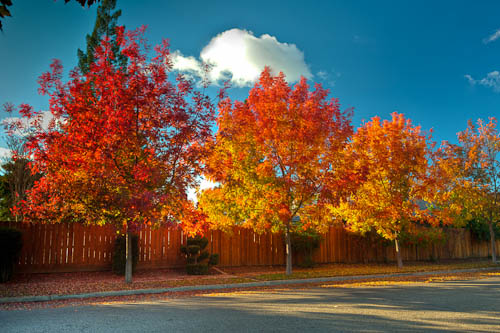
Seedling Chinese Pistache - Great Oranges and Reds - but colors will vary since each tree came from seed.
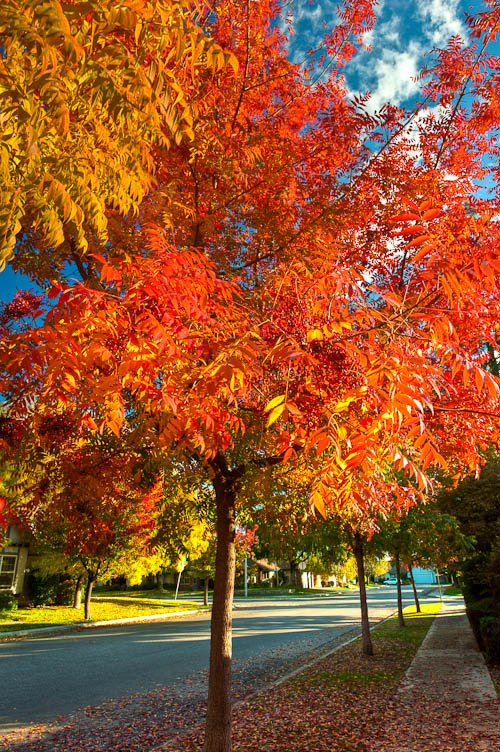
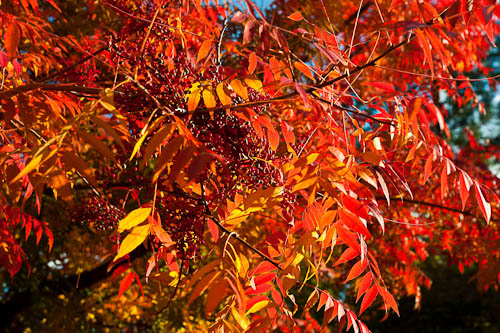
Look close and you can see the red seeds among the foliage. Pretty but slippery on the cement sidewalks which is why I like the Keith Davies.
Persimmons
Most people only think of the orange-red fruit of the persimmons which ripen in the fall and provide their own fall ornamental value along with good eating.
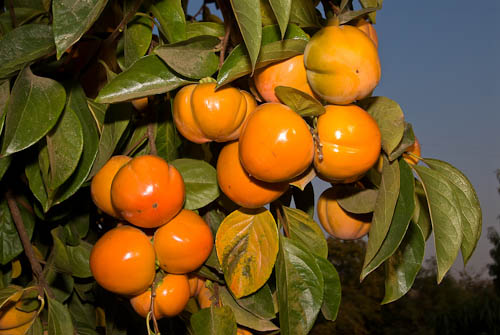
Many persimmons also have colorful fall foliage:
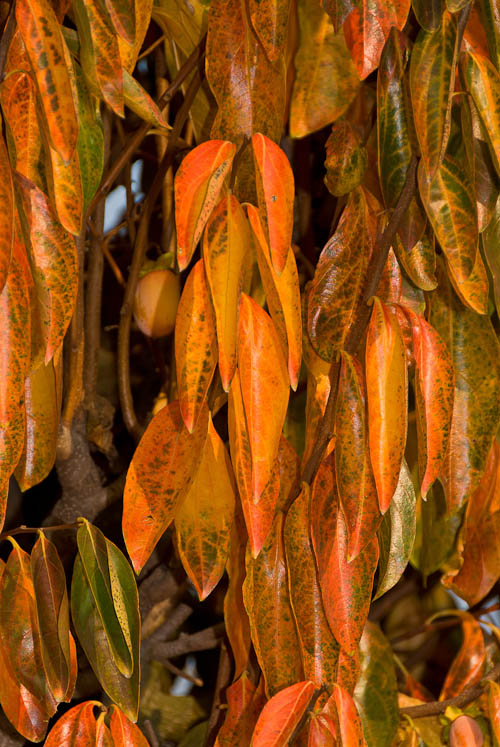
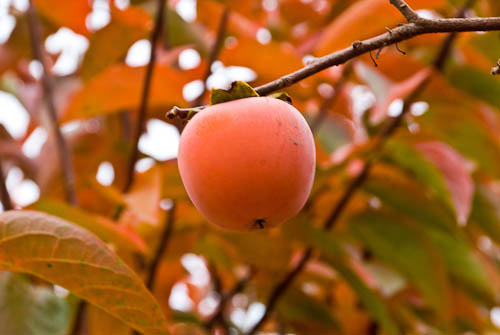
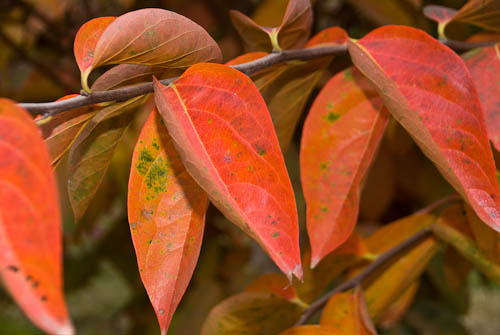
Forest Pansy Redbud
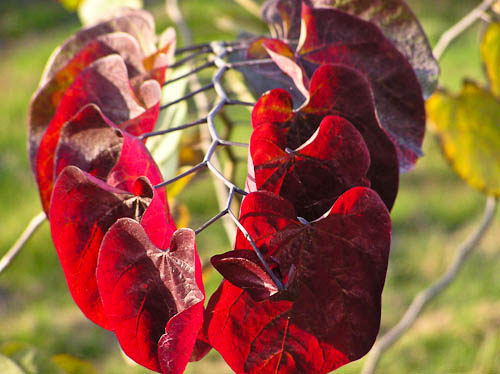
This November photo shows the new growth still vibrantly red. Older foliage is turning a non-spectacular yellow.
Trident Maple (Acer buergeranum) Our environment, like many of yours, is not conducive to successfully growing many of the great maples seen in the acidic soils of the east. I like the Trident Maple because it is a tough tree that handles our slightly alkaline soils and high summer temperatures. It provides good fall color as well.
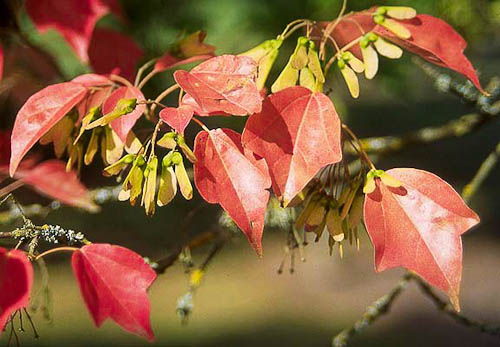
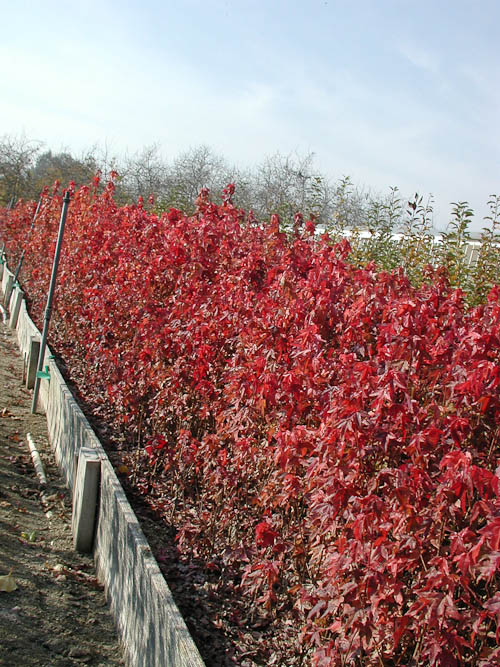
Seed bed full of Trident Maple (Acer buergeranum) seedlings showing red fall color.
Autumn Fantasy Maple
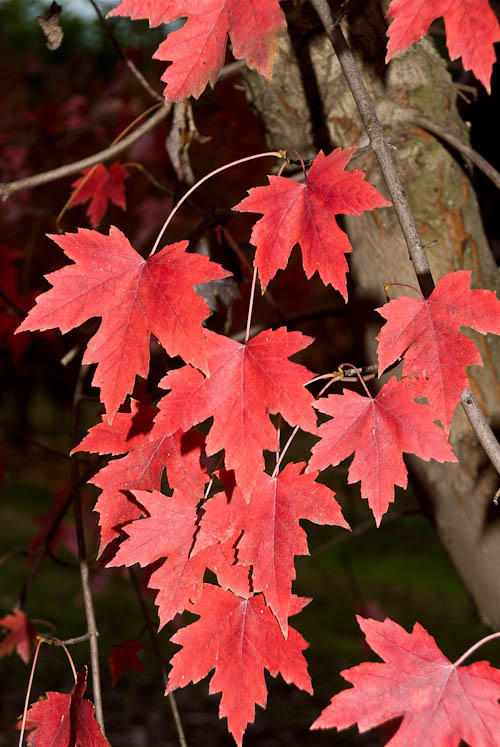
Golds & Yellows
European White Birch
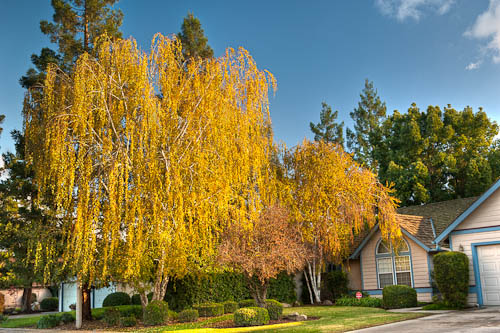
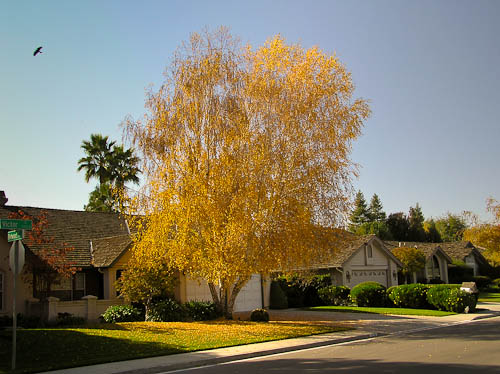
There are several plantings of Clump European White Birth (Betula pendula alba) in my neighborhood which provide attractive golden fall color.
Golden Desert Ash
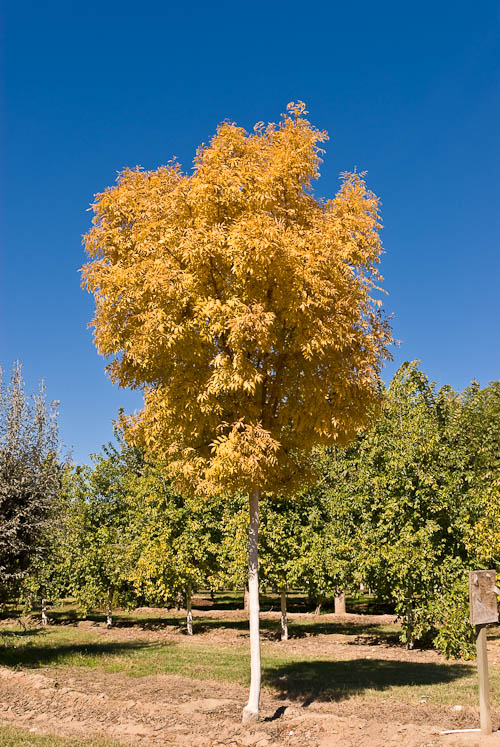
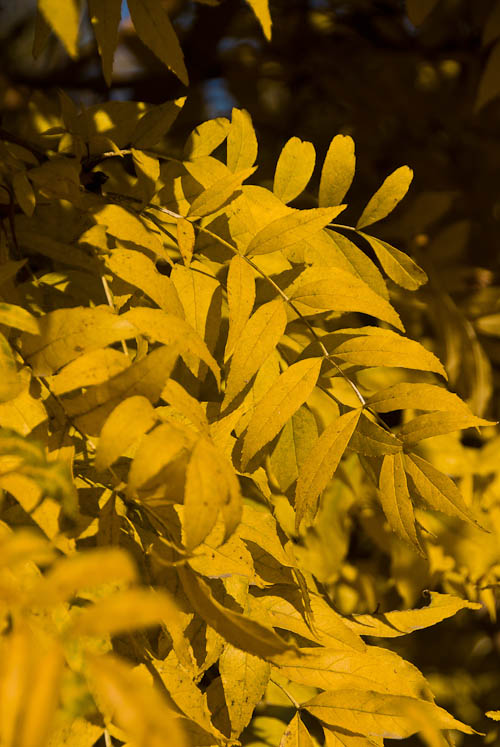
All summer long the Golden Desert Ash has a nice golden color which is especially showy against a green backdrop. In the fall, the golds turn even more golden.
Populus
Basically all the Populus family has attractive golden-yellow fall colors and there is not enough room to show them all here. I want to feature the Silver Leafed Poplars that have attractive green/silver summer foliage that turns into a stunning golden show in the fall.
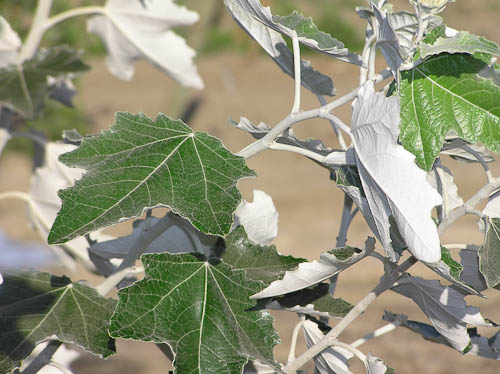
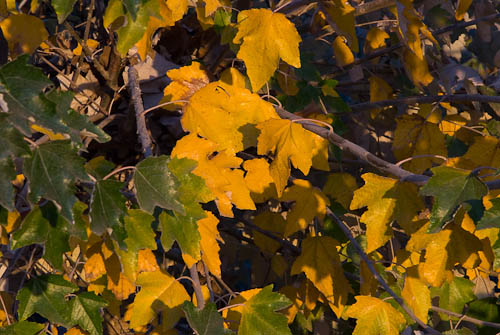
Autumn Purple Ash
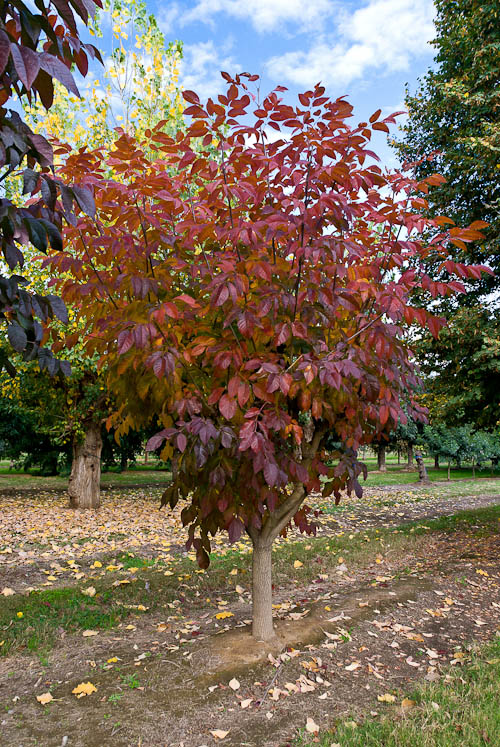
(Ignore the shape - this is a tree we butcher yearly to get budwood - use your imagination)
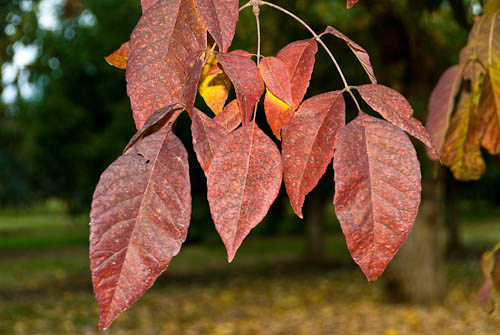
Autumn Purple Ash has attractive fall colors in the burgundy-purple ranges. This tree is an excellent shade tree in the summer and should have wider use.
And this was a brief photo walk around the block and a brief stop in the budwood orchard. What colors do you want to add to your landscape to enjoy for many years to come?
Ron Ludekens 11-20-2010
Identifying Unknown Peach
This peach is aproxamately the size of a softball at ripen, it is a white meat and not nearly as sweet as the golden meated peaches. It also is a freestone and has an abundance of juice to each fruit.
I am sugar sensitive and cannot eat the regular "golden meats" in any quantity. These wonderful peaches were so much less sweet that I could enjoy a whole peach right from the tree. I do so miss this fruit and would greatly appreciate any information I could get re guarding it.
Thank you for your time and efforts, sincerely, Lisa - Boley, OK
P.S. The regular Large Elberta peach in your listing greatly resembles my peach.
Answer:
Lisa, I am puzzled by your question and observations. As a rule of thumb, white flesh peaches are very sweet, soft and watery (abundance of juice) and for the most part less flavorful that yellow peaches. On the opposite end, yellow fleshed peaches generally have more flavor and are more firm. Some yellow peaches are very 'acidic' and have a strong flavor but not as much sweetness. These are the kind my father likes to eat. Other peaches tend to be more on the sweet side, less sub-acid and sometimes softer and juicier. My preferences lean to the sweeter choices. Thus I am confused by your sugar sensitivity and aversion to yellow peaches when it is the white fleshed peaches that should cause a bigger problem.
To my knowledge all the Elberta and similarly Elberta-named peaches are yellow fleshed - not white. But they do have great flavor and enough sweetness to make my taste buds very happy.
We used to grow the Hal-berta Giant Peach which was a very large peach with pink blush yellow skin, sweet yellow flesh, freestone and ripened in August. It might be similar to the one you are describing.
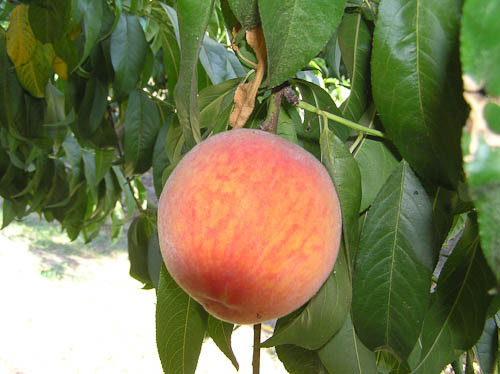
These were mostly sold in the northern half of Texas. We discontinued growing it a number of years ago since sales we so small - a shame since I think it was one of the better peaches.
One you might like to try is the Loring Peach which will do in your colder area, has a nice blend of sweet and flavor and even has a nice spring bloom.
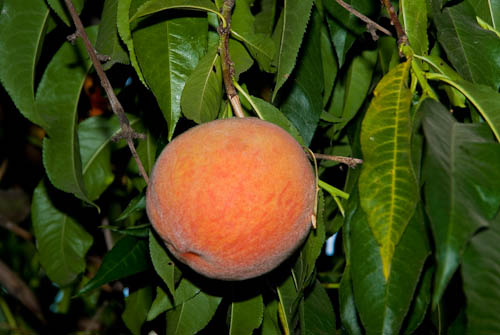
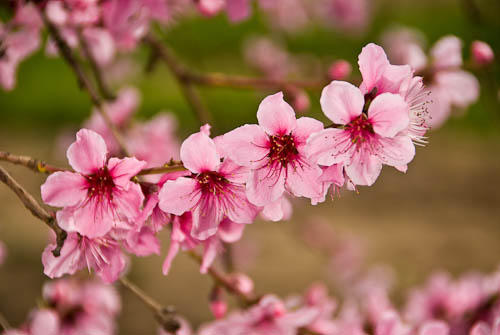
I am sure you can find some Loring Peaches in one of the Independent Retail nurseries near you or at least in Oklahoma City.
I hope this has been of some help.
Ron
Thumbs Up
Today we culminated a week of sales training with a walk through the fields and budwood orchards.
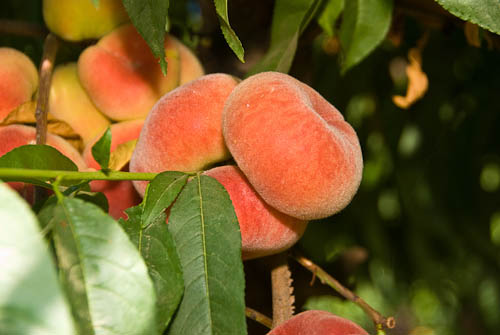
As we passed the ripe Donut (Saturn) Peaches and were refreshing ourselves with their sweet, sugery goodness, I recalled a conversation I had with a customer earlier this year in Texas. As I was describing the improvement of size and flavor of the Galaxy Peach over the Donut Peach, he commented, "can you pop the seed out of the Saturn Peach like I do with the Donut Peach?"
"Huh?"
"Yeah, I use my thumb and pop the seed right out of the peach and it looks like a donut - hole and all. Now you can eat the whole thing."
Since I had never tried this or heard of such a thing, I plead ignorance.
Today, we got to try it. Or at least Kevin did while we watched. (As the newest member of our sales staff, he gets volunteered for a lot of things.)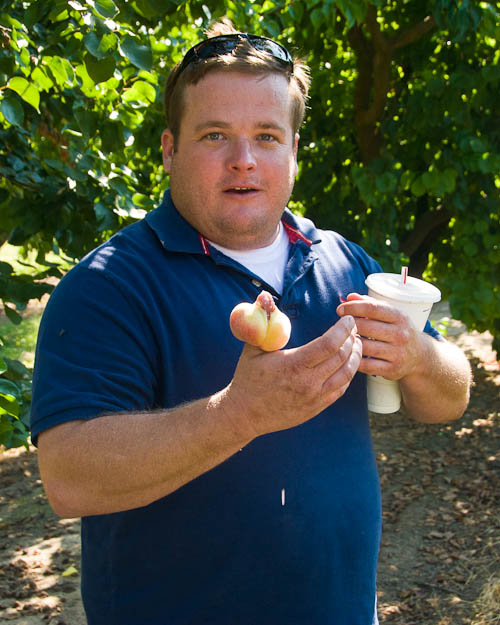
Guess what, it works! 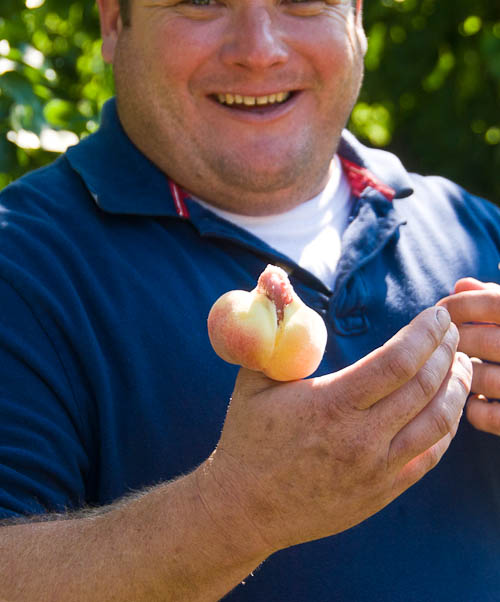
Seed is gone. Now what?
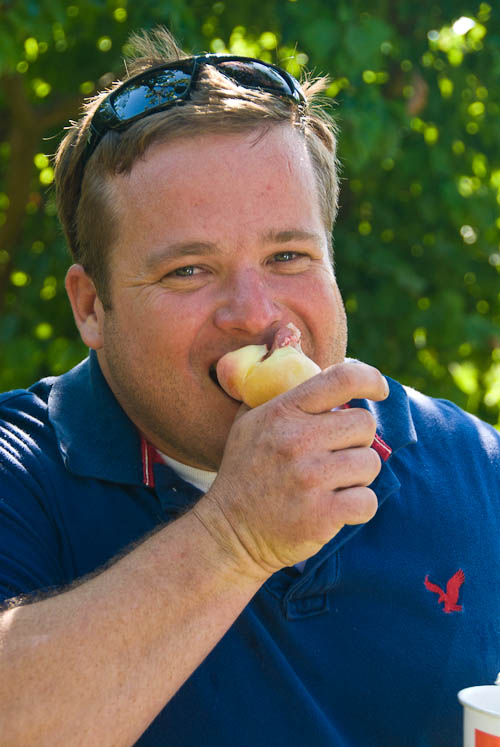
Seems a new way to eat Donut Peaches has been discovered.
What about the Galaxy Peach?
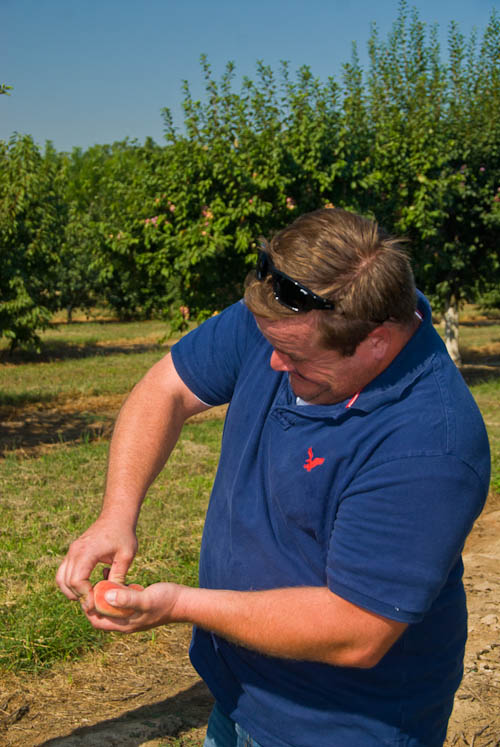
Here is Galaxy Peach. Larger for sure. But about a week or so before it is fully ripe. Peach pits do not pop well out of hard, unripened peaches - so we decided to save Kevin's thumb for another week. To be continued....
Ron Ludekens
Tropic Gold Apricot - Loaded!
I had to show you this tree absolutely loaded with fruit! It looked like a weeping tree 2 weeks ago. For not thinning anything, the fruit was nice sized too.

Tropic GoldTM produces medium to large, excellent tasting apricots in late June to early July.
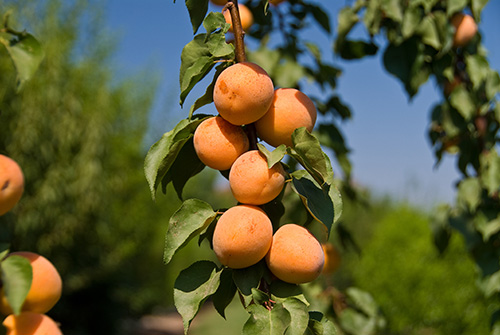
As you can see they are yellow with orange cheek. Fruit is firm and juicy. Good for fresh eating, canning and dehydrating. It is self fertile.
A good apricot for mild winter areas. It fruits every year in Camarillo, California where this tree originated. Another very popular apricot, Blenheim does not consistently fruit in the same location which is what caught our attention to Tropic Gold. Chilling hours is estimated at 350 hours opening up wide areas with mild winter climates to this delicious fruit.
We introduced this tree to the trade in 2005 and sales continue to be ever increasing.
I hope you have a chance to enjoy them.
For more photos of this crop go to Tropic Gold Apricots and Tropic Gold Apricot

